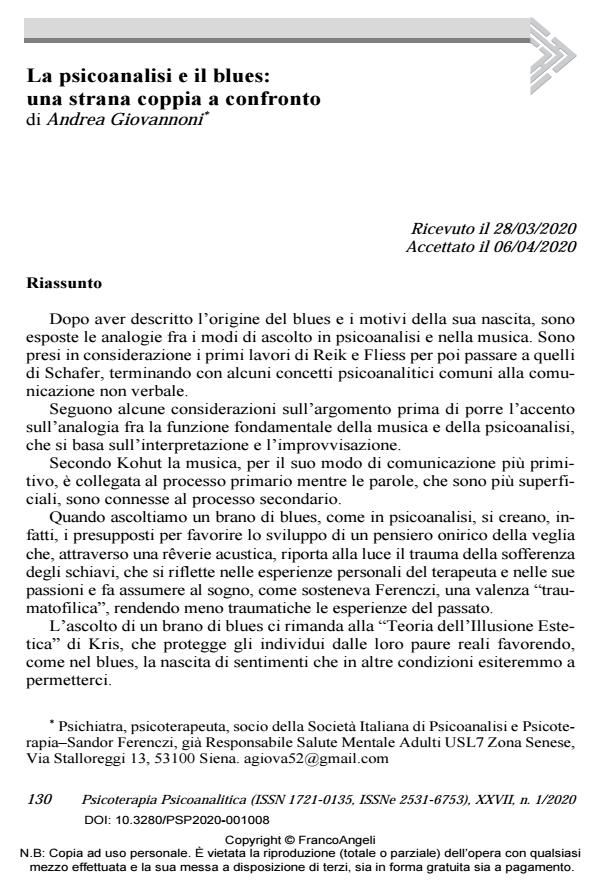Psychoanalysis and the Blues: an unexpected comparison
Journal title PSICOTERAPIA PSICOANALITICA
Author/s Andrea Giovannoni
Publishing Year 2020 Issue 2020/1
Language Italian Pages 21 P. 130-150 File size 248 KB
DOI 10.3280/PSP2020-001008
DOI is like a bar code for intellectual property: to have more infomation
click here
Below, you can see the article first page
If you want to buy this article in PDF format, you can do it, following the instructions to buy download credits

FrancoAngeli is member of Publishers International Linking Association, Inc (PILA), a not-for-profit association which run the CrossRef service enabling links to and from online scholarly content.
After explaining the birth of the Blues and the reasons for it, there follows a description of the analogies between the forms of listening in psychoanalysis and music. The first works by Reik and Fliess are taken into consideration, then those by Schafer, with a brief overview of some psychoanalytic concepts about nonverbal communication. The core functions of music and psychoanalysis seem to be very much the same, in that both music and psychoanalysis rely on interpre-tation and improvisation. Kohut associated music with the primary process, because of its more primitive way of communicating, while words, that are more su-perficial, are associated with the secondary process. As is the case in psychoanalysis, when we listen to a Blues song, preliminary assumptions are created to favour the development of day-time oneiric thinking: thanks to acoustic reverie, the Blues unveils the trauma of slaves’ sufferings, which is reflected by the analyst’s per-sonal experiences and passions. Dreaming then acquires a "traumato-philic" value, thus making past experiences less traumatic. Listening to a Blues song reminds us of Kris’ "theory of aesthetic il-lusion" which protects individuals from their real fears while favouring ‒ as in the Blues ‒ the development of feelings that we would not dare to get in touch with otherwise. Two clinical vignettes explain how to learn to play the Blues and what it means to play out of time. A comparison is made between the psychoanalytic setting and the twelve bar blues format, a pattern repeating itself in a precise and monotonous way so as to allow the production of a musical narrative (free associations) played on the five pentatonic scales.
Keywords: The Blues, hearing, countertransference, aesthetic illusion, therapeutic relationship.
Andrea Giovannoni, La psicoanalisi e il blues: una strana coppia a confronto in "PSICOTERAPIA PSICOANALITICA" 1/2020, pp 130-150, DOI: 10.3280/PSP2020-001008